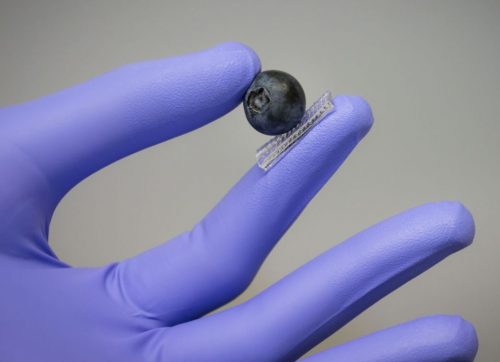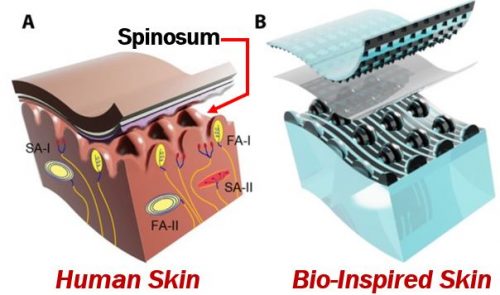A new electronic glove with sensors may one day give robots the sense of touch. It is thanks to our sense of touch that we have the extraordinary dexterity that most of us take for granted. Robots must also have this sense of touch if we want them to have our level of dexterity.
Zhenan Bao and members of her team at Stanford University created the electronic glove. They wrote about their work in the journal Science Robotics (citation below). Bao is a K. K. Lee Professor at Stanford’s School of Engineering. She is a Senior Fellow at the Precourt Institute for Energy, and also a Professor, by courtesy, of Materials Science and Engineering and of Chemistry.
The researchers demonstrated how sensitive the sensors in the electronic glove are. They work well enough to allow a robot’s hand to touch a delicate berry and handle a Ping-Pong ball. It did this without squashing the berry or dropping the ball.
Prof. Bao said:
“This technology puts us on a path to one day giving robots the sort of sensing capabilities found in human skin.”
The sensors in the electronic gloves
The sensors in the fingertips of the electronic glove measure the intensity and direction of pressure simultaneously. To achieve manual dexterity, these two qualities are essential, said Prof. Bao.
The research team still needs to perfect the technology to control these sensors automatically. When they have perfected it, a robot wearing the electronic glove will be able to automatically hold an egg. It will be able to hold it between forefinger and thumb without letting it slip or smashing it.

Electronic glove imitates human skin
The electronic glove imitates the way layers of our skin work together. By working together, our layers of skin give our hands their extraordinary sensitivity.
Outer layer
The outer layer has sensors that detect heat, pressure, and other stimuli. The palms of our hands and fingers are particularly rich in touch sensors.
Sublayer
We call this sublayer of skin the spinosum. The spinosum is a bumpy microscopic terrain of valleys and hills.
The bumpiness of the sublayer is critical. When we touch something with our fingers, the skin’s outer layer moves closer to the spinosum.
If we touch something lightly, only the sensors close to the hilltops feel it. If we touch something more intensely, the outer layer is forced down into the spinosum’s valleys. This subsequently triggers more intense touch sensations.
The spinosum measures not only pressure intensity but also the direction of pressure or shear force. If a finger, for example, presses north, it creates strong signals on the microscopic hills’ southern slopes.
It is thanks to our sense of shear force that we can gently but firmly hold an egg between forefinger and thumb.

Development of the electronic sensors
Co-authors Clementine Boutry and Marc Negre led the development of the electronic sensors that mimic what our skin does. Dr. Boutry is a Postdoctoral Scholar at Stanford’s Department of Chemical Engineering. Negre is a Masters Student at Stanford’s Materials Science and Engineering Department.
Each sensor on the fingertip of the electronic glove consists of three flexible layers. The three layers work in concert. The bottom and top layers are electrically active.
The research team laid a grid of electrical lines on each of the two facing surfaces, like rows in a field. They then turned these rows perpendicular (90°) to each other to create a dense array of tiny sensing pixels.
Like in the human skin’s spinosum, they also made the bottom layer bumpy.
Rubber insulator separating the layers
The top and bottom layers of electrodes had a rubber insulator between them to keep them apart. That separation, however, was critical because electrodes that are near each other without touching can store electrical energy.
The stored energy increased as the robotic finger pressed down and squeezed the upper electrodes closer to the bottom.
In a press release, Stanford University wrote:
“The hills and valleys of the bottom layer provided a way to map the intensity and direction of pressure to specific points on the perpendicular grids, much like human skin.”
Testing the technology in the electronic glove
The researchers then tested their technology. They placed their three-layered sensors on the fingers of the rubber glove. They then put the electronic glove on a robotic hand.
The researchers’ goal is to embed sensors directly into the robotic hand’s skin-like covering.
Experiment 1 – touching a berry
In their first experiment, the researchers programmed the robotic hand, which was wearing the electronic glove, to touch a berry. Specifically, to touch the berry without damaging or squashing it.
The experiment was a success.
Experiment 2 – a Ping-Pong ball
They then programmed the gloved robotic hand to lift and move a Ping-Pong ball. It had to do this without crushing the ball by using its sensors to detect the appropriate shear force. By detecting the right shear fore, it should be able to grasp the ball without dropping it.
This second experiment was also a success.
With the right programming, a robotic hand wearing this touch-sensing electronic glove could perform repetitive tasks. It could, for example, lift eggs on a conveyor belt and then place them into cartons.
The technology might also have applications in robot-assisted surgery. In surgery, dexterity and precise touch control are vital.
An electronic glove that needs no programming
Prof. Bao’s goal, however, is to develop an advanced version of the electronic glove. The glove would not require prior programming. In other words, it would be able to apply the right amount of force to handle things automatically.
Prof. Bao said:
“We can program a robotic hand to touch a raspberry without crushing it, but we’re a long way from being able to touch and detect that it is raspberry and enable the robot to pick it up.”
Roboticists across the world are trying to improve robots’ dexterity. Researchers at the University of Glasgow in Scotland designed ‘Dexterous Blue.’ Dexterous Blue is an 8-foot tall robot that can sort and fold clothes.
Citation
“A hierarchically patterned, bioinspired e-skin able to detect the direction of applied pressure for robotics,”
Clementine M. Boutry, Marc Negre, Mikael Jorda, Orestis Vardoulis, Alex Chortos, Oussama Khatib, and Zhenan Bao. Science Robotics 21 Nov 2018, Vol. 3, Issue 24, eaau6914. DOI: 10.1126/scirobotics.aau6914.
